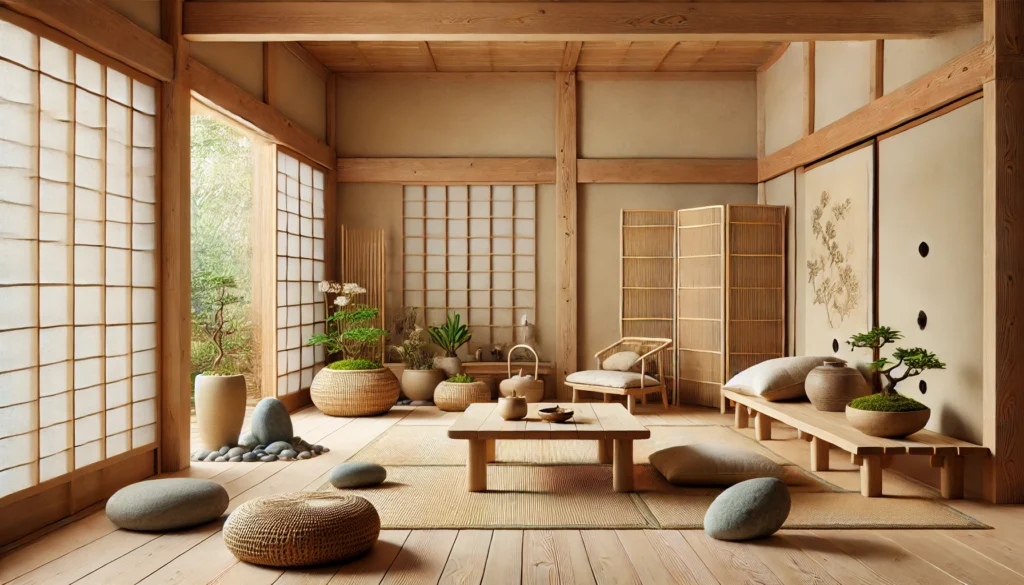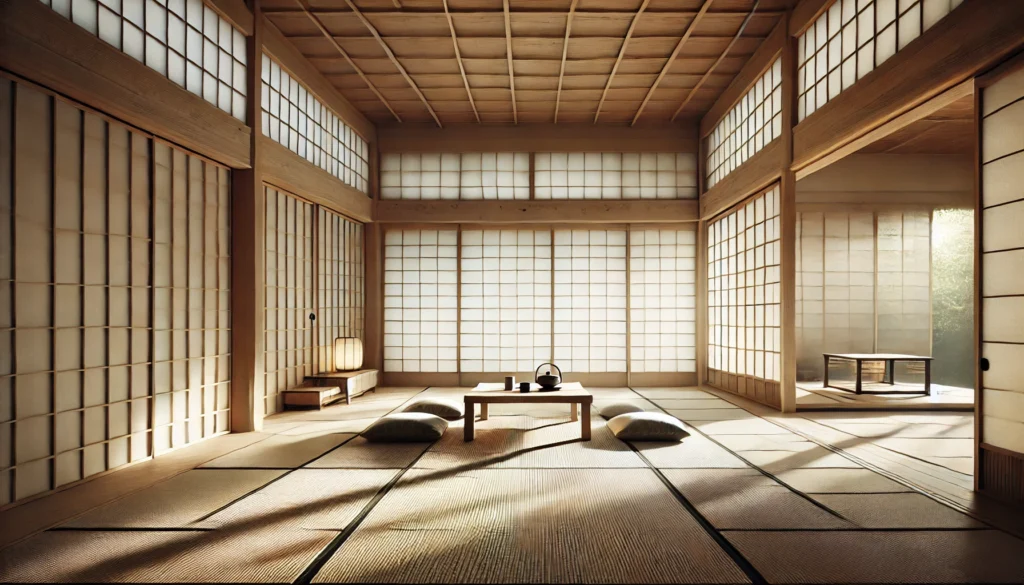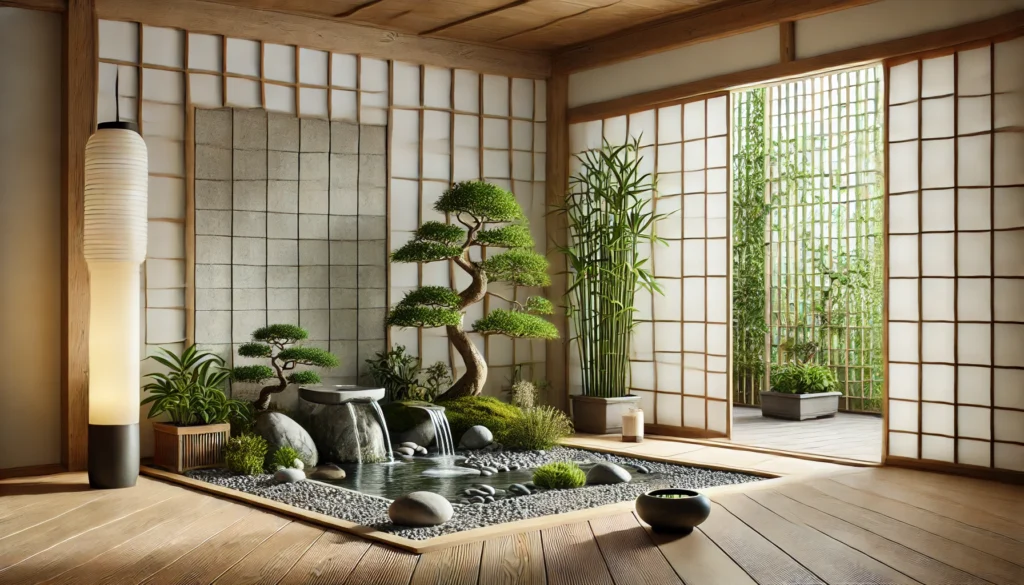Table of Contents
Introduction to Japanese Interior Design
Japanese interior design encapsulates a unique blend of aesthetic simplicity, nature-inspired elements, and a profound spiritual essence that is often characterized by the principles of Zen. This design philosophy is deeply rooted in Japan’s historical and cultural landscape, evolving through centuries of tradition and practices that emphasize tranquility and harmony. The minimalist aesthetic is a prominent feature, where less is used to create more, prioritizing functionality and the elimination of clutter.
One of the fundamental concepts underpinning Japanese interior design is the seamless integration of indoor spaces with the natural surroundings. This design approach seeks to foster a sense of connection with nature, often achieved through the use of natural materials such as wood, stone, and paper. Large windows or sliding doors, known as shoji, are commonly employed to facilitate this connection, allowing an abundance of light while inviting the outside elements into the home. Such designs create a fluid transition between the interior and exterior, promoting a tranquil living environment.
The philosophy of Zen plays an invaluable role in shaping the principles of Japanese interior design. Zen encourages mindfulness and reflection, leading to the creation of spaces that are not only aesthetically pleasing but also conducive to peace and meditation. This influence is reflected in the use of neutral color palettes, simple lines, and open spaces that encourage relaxation and introspection. Each piece of furniture and decor is selected with intention, ensuring that every element within the space contributes to its overall serenity.
The historical influences that shape Japanese interiors, such as Buddhism and Shintoism, also contribute to their cultural significance. These traditions emphasize respect for nature and simplicity, principles that remain central to the contemporary applications of Japanese interior design. Understanding these fundamentals enables one to appreciate the beauty of creating a serene living space inspired by Japanese aesthetics.

Key Principles of Zen Spaces
Zen spaces, rooted in the principles of Japanese interior design, are crafted to evoke a sense of simplicity, balance, and tranquility. Central to this design philosophy is the idea of simplicity, where less is often more. In a Zen environment, each element serves a purpose, allowing for an uncluttered and organized atmosphere that promotes mindfulness and relaxation. The choice of colors plays a pivotal role in achieving this simplicity. Soft, neutral hues such as whites, beiges, and light grays are frequently employed to create a calm, inviting backdrop, while accents of natural colors like greens and earthy browns help to foster a connection with nature.
Balance, another fundamental principle of Zen design, is achieved through the harmonious arrangement of furnishings and decor. This helps create a flowing energy within the space, ensuring that no single element overpowers the others. When selecting furnishings, it’s essential to choose pieces that are not only aesthetically pleasing but also functional, as they contribute to the overall zen-like experience. Natural materials, such as wood, stone, and bamboo, are often preferred in Zen spaces, as they further enhance this balance and tie the environment back to nature.
Tranquility is the ultimate goal of a Zen space, serving as a sanctuary for relaxation and reflection. This can be enhanced through the strategic use of negative space—leaving areas intentionally bare to discourage clutter and distraction. The practice of decluttering not only clears physical space but also promotes mental clarity. In cultivating a peaceful environment, one creates a refuge from the chaos of everyday life, where individuals can retreat to recharge. By embodying these key principles of Zen design, a truly serene and harmonious space can be achieved, perfectly aligning with the ethos of Japanese interior design.
Color Palettes in Japanese Interiors
Japanese interior design is deeply rooted in the appreciation of nature, which is reflected in its preferred color palettes. The primary emphasis is placed on muted tones and earth colors that resonate with the surrounding environment. These color choices aim to promote a sense of serenity and balance, crucial elements in Zen philosophy. When designing a Zen space, it is beneficial to select colors that evoke the tranquility found in nature, such as soft browns, gentle greens, and muted blues.
The traditional approach often utilizes colors derived from natural materials, such as wood, stone, and foliage. For instance, the rich hues of unvarnished wood—ranging from light beige to deep walnut—serve as neutral backdrops that complement other design elements. The result is a harmonious blend that fosters an atmosphere conducive to relaxation and mindfulness. Incorporating such natural colors allows for seamless transitions between indoor and outdoor spaces, aligning with the Japanese concept of ‘Wabi-Sabi’, which emphasizes beauty in imperfection and impermanence.

Seasonal changes also play a significant role in determining color choices in Japanese interiors. During spring, soft pastels resembling blooming cherry blossoms may find a place in home decor, while autumn may inspire deeper, warmer tones reminiscent of falling leaves. This adaptive approach not only enhances the aesthetic appeal of a space but also allows for a dynamic reflection of the ever-changing environment. When creating a Zen-inspired interior, it is essential to consider how these seasonal influences can inform your color palette, promoting a continuous dialogue between the interior space and the natural world.
Natural Materials and Textures
In the realm of Japanese interior design, the use of natural materials is paramount. These elements, such as wood, paper, stone, and textiles, serve not only an aesthetic purpose but also create a profound connection to nature, which is an essential aspect of Zen philosophy. The inclusion of these materials fosters an environment that encourages tranquility and mindfulness, suitable for a serene living space.
Wood, in its various forms, is a staple in Japanese design. Commonly used types include cedar, pine, and cherry. The rich textures and natural grains of wood bring warmth and comfort to any room. When integrating wood into your space, consider furniture pieces that highlight these characteristics, such as a plain wooden table or timber shelving. Additionally, wooden accents, such as beams or sliding doors—known as ‘fusuma’—can create a seamless flow between indoor and outdoor spaces, further enhancing the natural aesthetic.
Another fundamental material is paper. Shoji screens, made from thin rice paper, allow natural light to permeate while maintaining privacy. Incorporating such elements can significantly elevate the soft ambiance of a room. In modern applications, one might consider using rice paper lamps or wall coverings, which lend a subtle elegance and a sense of calm.

Stone and various textiles also play crucial roles in establishing a Zen atmosphere. Stone elements like slate or granite can be integrated as flooring or decorative pieces, creating a grounding effect. Meanwhile, natural textiles—wool, cotton, or linen—can be utilized in furnishings, curtains, and throws to provide softness and comfort without overwhelming the senses.
When sourcing these materials, prioritize local and sustainable options to truly resonate with the spirit of Japanese design. By carefully selecting and thoughtfully integrating these natural elements, one can achieve a space that embodies serenity and fosters a profound connection to the natural world.
The Role of Light and Space
In Japanese interior design, the interplay between light and spatial arrangement is paramount for achieving a Zen atmosphere. Natural light plays a crucial role in creating a serene environment that encourages relaxation and mindfulness. Maximizing the use of daylight is essential, as it fosters a sense of connection with nature, which is a cornerstone of the Zen philosophy. Large windows, strategically placed to capture sunlight, invite the outside world in, transforming the interior into a tranquil sanctuary.
One effective technique for enhancing natural light is the use of sliding doors, or fusuma. These doors, made from lightweight materials and often adorned with minimalistic designs, not only provide privacy but also allow for flexibility in spatial arrangement. When opened, fusuma can facilitate a seamless transition between indoor and outdoor spaces, creating a harmonious flow that exemplifies the essence of Japanese design. This fluidity reduces visual barriers, making the space appear larger and more inviting, thereby promoting a sense of calm.
In addition to utilizing light effectively, the arrangement of furniture is critical in crafting an airy and peaceful environment. Furniture should be positioned to enhance accessibility and movement within the space. By opting for low-profile furniture, one can maintain an unobtrusive and uncluttered look. This not only facilitates ease of movement but also makes the room feel more expansive, allowing for a meditative flow that is essential for a Zen space. Furthermore, choosing multi-functional pieces can help minimize clutter, thus reinforcing a peaceful atmosphere.

Ultimately, the careful consideration of light and space can significantly influence the overall ambiance of a room. By prioritizing natural light and adopting intentional spatial arrangements, one can effectively create a Zen space that invites tranquility and promotes relaxation.
Incorporating Nature: Indoor Gardens and Water Features
Nature plays a pivotal role in Japanese interior design, creating spaces that foster a unique connection between the indoors and the natural world. Integrating elements such as indoor gardens, bonsai trees, and water features into your home can significantly enhance the tranquil atmosphere that is characteristic of this design philosophy. Considering the psychological benefits of nature, these elements evoke a sense of peace and harmony that can transform any living space.
One effective way to bring nature indoors is through the creation of an indoor garden. These environments can be customized to suit the available space and preferences of the homeowner. For smaller homes, vertical gardens or terrariums can be a wonderful option, utilizing walls and corners to host a variety of plants. Larger spaces can accommodate more elaborate gardens, perhaps with stones and path-like arrangements that mimic the beauty of an outdoor landscape.
Moreover, incorporating bonsai trees into your home serves both as a design element and a living art piece. These miniature trees require care and attention, creating a mindfulness practice in maintaining them. Placing bonsai trees in strategic locations, such as near windows or focal points of a room, can draw the eye and enhance the overall aesthetic. Additionally, their historical significance in Japanese culture adds depth to their presence in your design.

Water features, such as small fountains or indoor koi ponds, can further amplify the calming effects of nature within your home. The gentle sound of flowing water promotes relaxation and can mask urban noise, creating a serene ambiance. Choosing the right size and scale of these features is essential; they should complement the space without overwhelming it. By accentuating the natural elements within your home, an atmosphere of tranquility and beauty can be achieved, embodying the essence of Japanese interior design.
Artwork and Decor in Zen Spaces
In the pursuit of creating a Zen space, the careful selection of artwork and decor plays a pivotal role. The philosophy of Zen emphasizes simplicity and tranquility, and incorporating elements that reflect these principles can greatly enhance the overall aesthetic of a room. Minimalist art, for instance, is an ideal choice when aiming for a serene ambiance. This style prioritizes clean lines, subtle color palettes, and open spaces, which align perfectly with the essence of Zen. Artworks that capture nature, such as landscapes or abstract forms inspired by the elements, can evoke a sense of calm and connection to the natural world.
Calligraphy is another significant aspect of Zen decor, often embodying profound philosophical concepts in its elegant strokes. The beauty of Japanese calligraphy lies in its ability to convey depth of meaning through simplicity. Selecting calligraphic pieces that resonate with personal values or aspirations may not only beautify a space but also invite contemplation, encouraging an atmosphere conducive to mindfulness. The incorporation of thoughtful words or phrases can serve as gentle reminders, fostering a deeper connection to the Zen philosophy.

Furthermore, traditional crafts such as Ikebana (flower arranging) and ceramics can enhance the Zen atmosphere. Ikebana celebrates the beauty of nature and imperfection, representing the theory of wabi-sabi. When arranged thoughtfully, even a simple flower arrangement can transform a room, bringing life and harmony. Similarly, handcrafted ceramics, with their unique textures and forms, embody authenticity and artistry, thus contributing to a balanced aesthetic. In creating a Zen space, it is essential to select artwork and decor that not only please the eye but also evoke a sense of tranquility and intentionality, reflecting the serene spirit of Zen living.
Furnishings: Choosing and Arranging for Comfort
When creating a Zen space, the selection of furnishings plays a pivotal role in establishing a tranquil atmosphere. Choosing the right furniture involves focusing on simplicity, functionality, and comfort. Low-profile furniture is highly recommended; it facilitates a sense of spaciousness and complements the minimalist aesthetic that characterizes Japanese interior design. Pieces such as low sofas, floor cushions, and tatami mats not only provide comfort but also create an inviting area for relaxation and meditation.
In terms of materials, opting for natural elements is essential. Wood, bamboo, and rattan are preferable choices that resonate with the earthy tones often found in Zen spaces. They not only enhance the overall aesthetics but also contribute to a soothing environment. When it comes to color palettes, neutral shades such as beige, gray, and soft whites induce calming vibes while still allowing for versatility in furnishing arrangements.
The arrangement of furniture is equally important in fostering a serene environment. To promote relaxation, consider utilizing a layout that encourages open space. Avoid overcrowding the room; instead, aim for a balance that allows for free movement and visual calmness. Placing furniture to create cozy nooks can further enhance the inviting nature of the room. For instance, positioning a low table surrounded by cushions in a corner can serve as a perfect spot for quiet reflection or casual gatherings.
Incorporating multifunctional furniture can also help maintain a clutter-free space. Consider items such as benches with storage underneath or low tables that can be easily moved. This flexibility aids in adapting the area for different activities while adhering to the ethos of simplicity prevalent in Zen design. Thoughtful selection and arrangement of furnishings can thus transform an ordinary room into a peaceful sanctuary, embodying the essence of Japanese interior design.
Maintaining a Zen Space: Rituals and Practices
Creating a Zen space is just the beginning; it is equally important to maintain it through daily rituals and practices that reinforce the tranquil atmosphere. Mindful decluttering is a fundamental practice in this process. It involves evaluating your belongings and consciously deciding which items contribute positively to your space. Set aside a few minutes each day or week to assess your possessions, removing those that no longer serve a purpose or bring joy. This practice not only keeps the physical environment clean but also mentally invigorates you, fostering a sense of clarity and focus essential for Zen living.
Regular cleansing rituals also play a vital role in preserving the serenity of your environment. These rituals can involve simple activities like opening windows to let fresh air circulate, burning incense or sage, or using essential oils that resonate with you. These actions help to energetically clear the space, eliminating stagnant energy and creating an atmosphere conducive to relaxation and mindfulness. It is important to establish a consistent schedule for these cleansing practices, whether weekly or monthly, to ensure that your Zen space remains pure and inviting.
Incorporating meditation or mindfulness practices into your daily routine further enhances the tranquility of your Zen space. Designate a specific time each day to engage in meditation, even if just for a few minutes. This dedicated practice allows you to center your thoughts and cultivate inner peace, which will permeate your surroundings. Mindfulness can also be practiced in everyday activities, such as mindful eating or conscious breathing throughout the day. This attentiveness to the present not only reinforces your Zen principles but also transforms everyday actions into opportunities for maintaining a harmonious environment.
By integrating these rituals and practices into your routine, you ensure that your Zen space remains a sanctuary for peace and serenity, reflecting the core principles of Japanese interior design and mindfulness.






